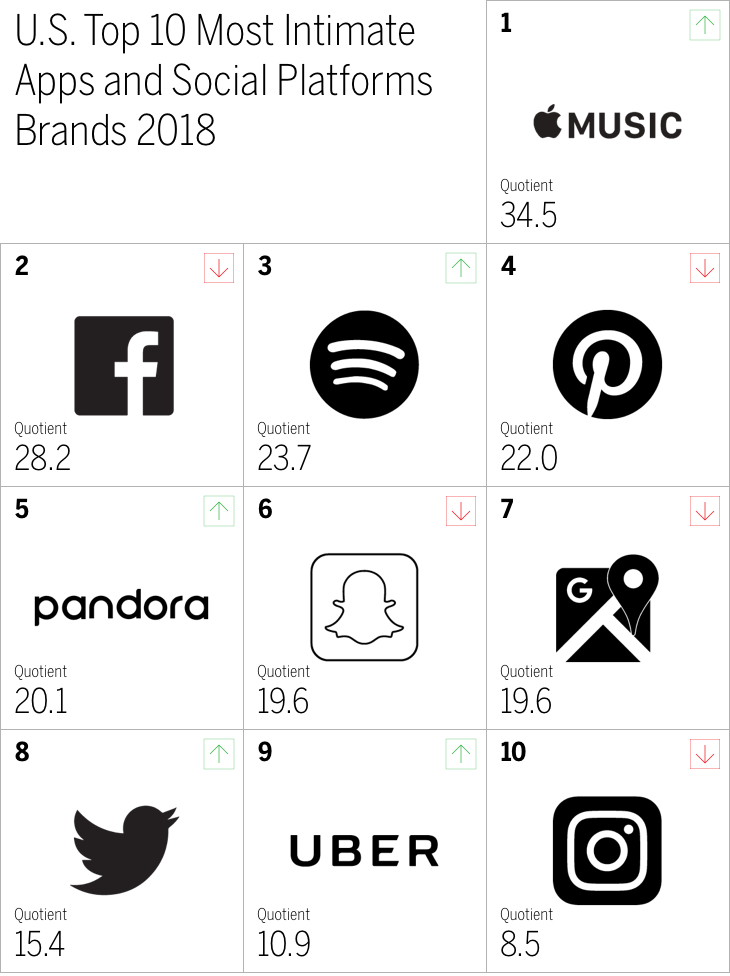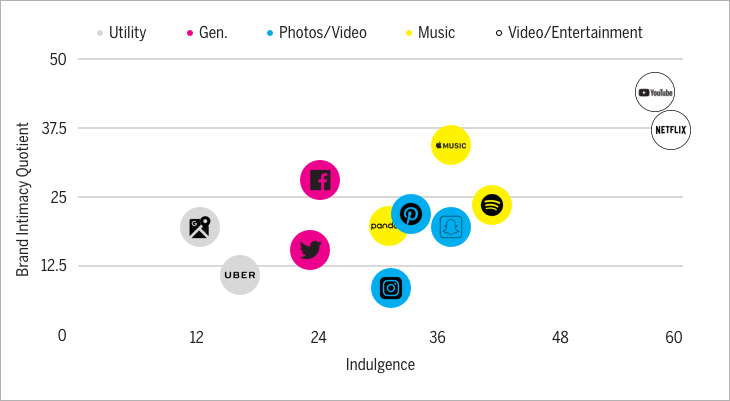Overview
- Despite the popularity of apps & social platforms, the industry ranks 12th out of 15 in our 2018 Brand Intimacy Study
- Overcoming barriers like trust and a loss of connection and communication is essential and some brands have taken important first steps in the right direction
- Among other things, leveraging new technologies and establishing a stronger presence on multiple devices are two key strategies that will help apps & social platforms build Brand Intimacy
To understand the below-average performance of the apps & social platforms industry in our 2018 Brand Intimacy Study, we’ve written a two-part article that addresses the industry’s key barriers to intimacy and the strategies to overcome those barriers, respectively.

In part I, we discussed how a lack of trust keeps brands in this category from forming stronger bonds with users and how corporate and political influence can damage the core values of connection and conversation for these brands. Additionally, we detailed the fact that this is a nascent industry with a utility orientation and that the hierarchy of the smartphone ecosystem causes users to place more value on device manufacturers than they do on apps & social platforms. In part II, we’ve proposed strategies for overcoming these barriers and for building Brand Intimacy in this rapidly changing industry.
Five strategies for building Brand Intimacy
1. Rebuild trust to rebuild connections
There are real barriers that hold the apps & social platforms industry back from building more intimate bonds with consumers. The most obvious issue (especially for social media brands) is trust. Brands need to make it a priority to rebuild consumer trust in the brand and the brand’s intentions. This will encourage users to get closer to brands and to start connecting with them, not just through them.
In the case of Facebook, Mark Zuckerberg’s recent Congressional testimony was (mostly) a step in the right direction because he clarified that user data is being used instead of shared or sold. While this may have given some Facebook users peace of mind, the hearings also revealed that there is a lot of work to be done to convince the world that its biggest social platform is capable of protecting its users’ data, cracking down on hate group propaganda, and remaining politically unbiased when it comes to censorship. These challenges are no easy task; however, Zuckerberg affirmed that Facebook would work harder to tackle these issues and to provide clearer, simpler privacy settings. Whether these increased efforts will result in meaningful change has yet to be seen, but they are an important first step in proving the brand is worthy of its users’ trust.
2. Prioritize privacy and user experience
Ads are essential to the business model of most apps & social platforms, so they’re here to stay for the foreseeable future. However, while Facebook argues that targeted ads make for a higher-quality experience, these ads can make users feel like their privacy has been violated. Bots and fake accounts can make users feel misled or disconnected, and both can make the user experience less fun. Facebook and Twitter have taken steps to crack down on fake accounts, and users are beginning to demand more in terms of privacy following the Cambridge Analytica scandal; however, there is more to be done to ensure that our apps & social platforms are not overrun with marketing efforts to the point that it damages their core appeal.
One possible solution is new business models that allow for ad-free experiences. These solutions wouldn’t necessarily stop bots and fake accounts from hijacking the conversation, and major social platforms will likely always want to keep a free option to maintain their accessibility and popularity. Rather than try to eliminate ads from the experience altogether, it’s more important that brands increase their efforts to hold parties accountable for their activity on social platforms, and Facebook’s promise that it will require verified identities for political ads in the future is a good example of this.1 Although users generally don’t enjoy ads, it’s difficult to say whether an increase in ad spending on social and mobile will result in a less enjoyable experience; regardless, brands in this industry need to ensure that ads (both their quality and sheer volume) don’t sour the user experience with these services.
3. Explore environments outside of the smartphone ecosystem
The smartphone ecosystem has a powerful effect on consumers and can boost Brand Intimacy performance, but brands in this industry shouldn’t be afraid to live outside the smartphone as well. For example, music streaming apps are likely used in more environments than others because users access them through phones, computers, smart speakers, televisions, and cars. This makes it easier for users to separate, for example, Spotify from their smartphone and view it as its own entity, rather than as an extension of the device.
2-year Brand Intimacy performance for music streaming apps

If an app brand can get its users to think of the app as more than just a utility and a smartphone app, it has the potential to occupy a bigger role in their lives and build connections without having to stand in the shadows of highly intimate brands like Apple and Samsung. We believe this to be one of the many contributing factors in the success of streaming services in the 2018 Brand Intimacy Study, where three of the top five brands in this industry are music streaming apps.
Additionally, we see how brands like YouTube, which could be considered an app or social platform, and Netflix, which is largely experienced through its app, have grown to become bigger than these classifications. While these brands are used on smartphones, they both have a strong presence on other devices, notably smart television devices and computers. The result is that users’ experiences with these brands are not defined by a single device or situation. This is part of what makes these brands so strong, placing YouTube at #6 overall in our study and Netflix at #8, far above the top app, Apple Music, at #49.
4. Enhance the user experience with new technologies
One of the defining archetypes of this category is enhancement. That means that one of the main reasons users build relationships with apps & social platforms is that they make users smarter, more connected, and more capable. With new, exciting technologies on the horizon (and in some cases, already in the mainstream), brands in this industry need to leverage the connective capabilities of the Internet of Things (IoT), the immersive possibilities of virtual reality (VR) and augmented reality (AR), the convenience of mobile payments, and more. For each up-and-coming technology, apps & social platforms should consider how to become more useful to their users and view technology as an opportunity for further enhancement. We can see this happening today with brands like Facebook and Snapchat (as well as tech giants like Apple, Amazon, Google, and more) making significant investments in VR/AR and artificial intelligence.
Another advantage of these technologies (especially VR and AR) is the enormous potential for creating user experiences that are more emotional, which makes them valuable tools for building Brand Intimacy. Other technologies (especially IoT) will help brands strengthen their presence outside of the smartphone ecosystem and allow them to be seen as more than just an expected feature of the smartphone.
5. Entertainment is essential
In the 2018 Brand Intimacy Study, the top industry was media & entertainment. The consumer need to entertain themselves and escape reality has been a pervasive theme throughout our study for the last two years, and it appears to be making waves in the apps & social platforms industry as well. As we’ve noted, three of the top five brands in this industry are music streaming apps, which are more focused on providing entertainment than information. Utility apps like Google Maps and Uber, which are more information-centric, generally score lower, and social networks, which provide a combination of entertainment and information, fall somewhere in between.
Brand Intimacy Quotient by indulgence archetype score

To demonstrate the impact of entertainment in the Brand Intimacy data, the chart above compares the brand scores on the indulgence archetype, which is the archetype most associated with the media & entertainment industry and describes brand relationships that center on moments of gratification, to the Brand Intimacy Quotient. Generally, there is a trend that links indulgence to higher levels of Brand Intimacy in this industry. YouTube and Netflix have been plotted on the chart to show how entertainment brands that are closely related to the apps & social platform industry follow a similar pattern, only at a much higher level of Brand Intimacy.
Entertainment (content that is meant for pure enjoyment rather than information) is the biggest opportunity that apps & social platforms have to build bonds today. By creating entertaining experiences, brands improve their ability to resonate with consumers on an emotional level to drive deeper connections. This is another area in which leveraging technology will prove useful because emerging capabilities provide new ways of entertaining and engaging users.
Conclusion
Apps & social platforms have given billions of users access to compelling and useful tools, but in many ways, they have yet to become more than the services they provide or to stand for something that resonates deeply with their audiences. The strategies listed here are all meant to help brands navigate specific barriers in the industry, some of which we addressed in part I, but each strategy aims to build and strengthen relationships with users in ways that are more honest, more engaging, or more emotional.
One of the overarching challenges of this industry is that it poses a lot of questions that still need to be answered. What responsibility do social platforms have to protect user data? What are apps & social platforms worth if so many of them are free? How much time is too much to spend on your smartphone? How do these tools affect the way we communicate, socialize, and live?
In an industry that is uniquely tied to consumer behavior, personal data, and the sharing of information, establishing and fostering real relationships is essential to the needs of the user and the value of the brands. If these brands hope to become more than just popular digital services, they need to take steps toward building the deep, emotional bonds that make users feel connected, respected, and appreciated.
Read our detailed methodology here and review the sources cited in this article here.
To learn more about MBLM, click here.
